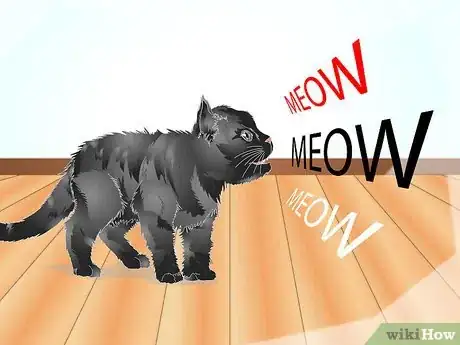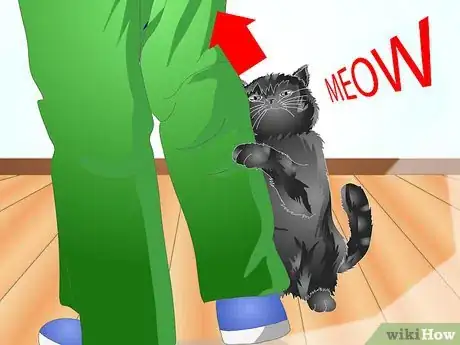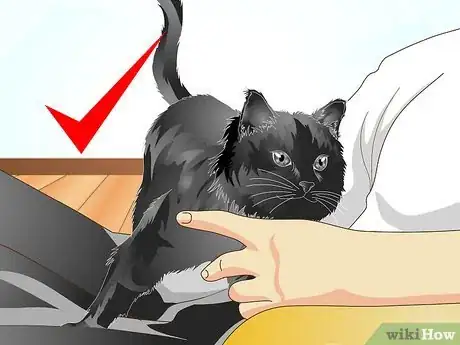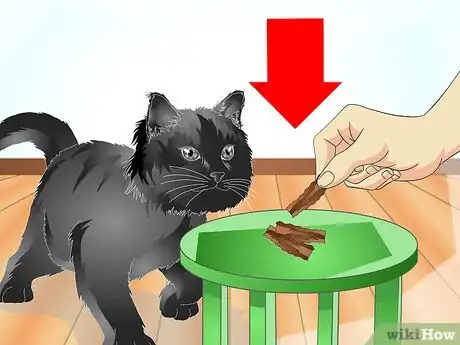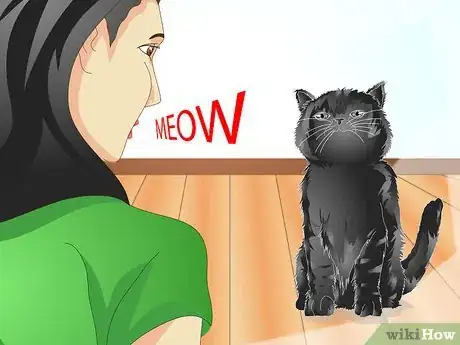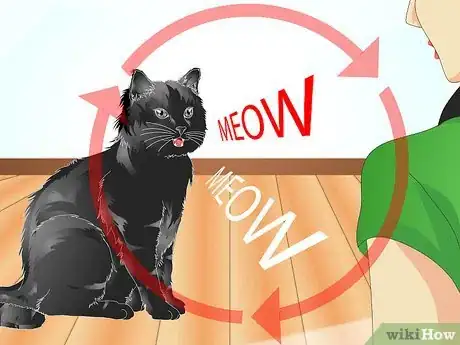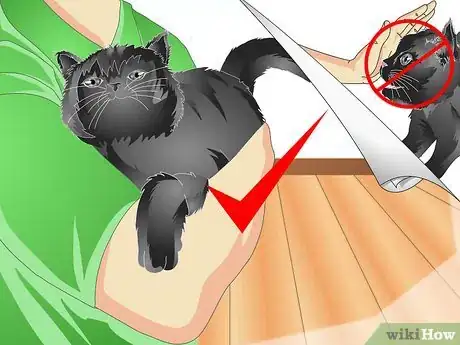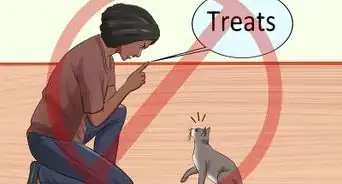This article was co-authored by Brian Bourquin, DVM. Brian Bourquin, better known as “Dr. B” to his clients, is a Veterinarian and the Owner of Boston Veterinary Clinic, a pet health care and veterinary clinic with three locations, South End/Bay Village, the Seaport, and Brookline, Massachusetts. Boston Veterinary Clinic specializes in primary veterinary care, including wellness and preventative care, sick and emergency care, soft-tissue surgery, dentistry. The clinic also provides specialty services in behavior, nutrition, and alternative pain management therapies using acupuncture, and therapeutic laser treatments. Boston Veterinary Clinic is an AAHA (American Animal Hospital Association) accredited hospital and Boston’s first Fear Free Certified Clinic. Brian has over 19 years of veterinary experience and earned his Doctor of Veterinary Medicine from Cornell University.
There are 7 references cited in this article, which can be found at the bottom of the page.
This article has been viewed 176,162 times.
Unlike dogs, cats have not historically been trained to perform tasks for people. They do not understand punishment, but do respond to positive reinforcement.[1] In fact, you probably already have taught your cat to talk, in some way. Cats are not naturally inclined to meow, but have learned to because they realize their owners will respond to them.[2]
Steps
Understanding Cat Communication
-
1Recognize the meow. Cats can make as many as 16 different meows. Paying attention to the different sounds can help you better communicate with your cat.
- A short meow is typically a greeting.
- Multiple meows signal excitement
- A mid-pitch meow is a request, likely for food.
- A deep “Mrow” is usually a complaint.
- A high pitch “Rroww!” is an indication of anger or pain.
- A long drawn out “mrrroww” is usually a demand.
-
2Understand what the meow is about. In nature, cats only meow as kittens to get attention for their mothers. When they realize you do not respond to their other signals, they learn to meow. Often the meow is a way to communicate something the cat wants, but it can have other meanings as well.
- Most frequently your cat’s meow is trying to articulate a request. A meow often means that they want food, attention, or to be allowed into a room.
- A meow can also signal distress. Cats vocalize when they are in heat, lonely, stressed, angry, or in pain. They also become more vocal when they get older.
- Other times a meow is a simple greeting similar to a “hello.”[3]
EXPERT TIPDr. Elliott, BVMS, MRCVS is a veterinarian with over 30 years of experience in veterinary surgery and companion animal practice. She graduated from the University of Glasgow in 1987 with a degree in veterinary medicine and surgery. She has worked at the same animal clinic in her hometown for over 20 years.Veterinarian
 Pippa Elliott, MRCVS
Pippa Elliott, MRCVS
VeterinarianPippa Elliott, a licensed veterinarian, makes this observation: "Older cats are more vocal, but it can often be for a reason. They may be losing their hearing or eyesight, or have a medical problem such as overactive thyroid glands. If their behavior is out of character, then see a vet."
Advertisement -
3Pay attention to nonverbal cues. Some of the most important ways that cats communicate are through body language. Cats, for example, have a complex language of signals that they make with their tails.
- When a cat looks you in the eyes and makes a long, slow blink, they are showing affection. This is sometimes compared to a kiss.
- A cat approaching you with their tail in the air is a greeting that suggests your cat is happy to see you. This has been compared to a handshake.[4]
- If the fur on your cats hair is standing up, this is a sign that they are angry or afraid.
- When your cat's tail is low, or between their legs, they are insecure or anxious.
- A tail thrashing back and forth is a sign that your cat is angry. The faster they move it back and forth, the angrier they are.[5]
Teaching Your Cat a Trick
-
1Make some time alone with your cat. Cats are easily distracted, so you should create a quiet and calm environment. Place your cat on the table in front of you and pet them to put them at ease.
-
2Get some treats. Place the treats on the table to get your cat’s attention. Cats are more likely to respond to treats that they aren’t accustomed to. Try to get something new.[6]
-
3Meow. Keep meowing until your cat meows and then give your cat a treat, and pet them. Continue as long as the cat is willing to participate.
-
4Repeat until your cat has learned the trick. After your cat no longer seems to respond, take a break. Try again the following day. Repeat every day until your cat regularly responds when you meow.
-
5
Expert Q&A
Did you know you can get expert answers for this article?
Unlock expert answers by supporting wikiHow
-
QuestionWhy should I avoid scolding my cat?
 Brian Bourquin, DVMBrian Bourquin, better known as “Dr. B” to his clients, is a Veterinarian and the Owner of Boston Veterinary Clinic, a pet health care and veterinary clinic with three locations, South End/Bay Village, the Seaport, and Brookline, Massachusetts. Boston Veterinary Clinic specializes in primary veterinary care, including wellness and preventative care, sick and emergency care, soft-tissue surgery, dentistry. The clinic also provides specialty services in behavior, nutrition, and alternative pain management therapies using acupuncture, and therapeutic laser treatments. Boston Veterinary Clinic is an AAHA (American Animal Hospital Association) accredited hospital and Boston’s first Fear Free Certified Clinic. Brian has over 19 years of veterinary experience and earned his Doctor of Veterinary Medicine from Cornell University.
Brian Bourquin, DVMBrian Bourquin, better known as “Dr. B” to his clients, is a Veterinarian and the Owner of Boston Veterinary Clinic, a pet health care and veterinary clinic with three locations, South End/Bay Village, the Seaport, and Brookline, Massachusetts. Boston Veterinary Clinic specializes in primary veterinary care, including wellness and preventative care, sick and emergency care, soft-tissue surgery, dentistry. The clinic also provides specialty services in behavior, nutrition, and alternative pain management therapies using acupuncture, and therapeutic laser treatments. Boston Veterinary Clinic is an AAHA (American Animal Hospital Association) accredited hospital and Boston’s first Fear Free Certified Clinic. Brian has over 19 years of veterinary experience and earned his Doctor of Veterinary Medicine from Cornell University.
Veterinarian
-
QuestionWhat does it mean when a cat rubs against your leg or presses its head on yours?
 Pippa Elliott, MRCVSDr. Elliott, BVMS, MRCVS is a veterinarian with over 30 years of experience in veterinary surgery and companion animal practice. She graduated from the University of Glasgow in 1987 with a degree in veterinary medicine and surgery. She has worked at the same animal clinic in her hometown for over 20 years.
Pippa Elliott, MRCVSDr. Elliott, BVMS, MRCVS is a veterinarian with over 30 years of experience in veterinary surgery and companion animal practice. She graduated from the University of Glasgow in 1987 with a degree in veterinary medicine and surgery. She has worked at the same animal clinic in her hometown for over 20 years.
Veterinarian
-
QuestionHow long does it take when teaching your cat to meow? EDITS: How long does it take to teach a cat to meow?
 Pippa Elliott, MRCVSDr. Elliott, BVMS, MRCVS is a veterinarian with over 30 years of experience in veterinary surgery and companion animal practice. She graduated from the University of Glasgow in 1987 with a degree in veterinary medicine and surgery. She has worked at the same animal clinic in her hometown for over 20 years.
Pippa Elliott, MRCVSDr. Elliott, BVMS, MRCVS is a veterinarian with over 30 years of experience in veterinary surgery and companion animal practice. She graduated from the University of Glasgow in 1987 with a degree in veterinary medicine and surgery. She has worked at the same animal clinic in her hometown for over 20 years.
Veterinarian That depends on the breed and how clever the cat is. Some breeds are more vocal than others, such as the Siamese cat, and so it's easier to get her to meow initially, and mark the behavior so she does it again. Other breeds such as the Persian are more silent and vocalization does not come naturally. In addition, some cats are clever and will cotton on to what you want in as short as a few minutes, whilst others take weeks, months, or may never "Get it".
That depends on the breed and how clever the cat is. Some breeds are more vocal than others, such as the Siamese cat, and so it's easier to get her to meow initially, and mark the behavior so she does it again. Other breeds such as the Persian are more silent and vocalization does not come naturally. In addition, some cats are clever and will cotton on to what you want in as short as a few minutes, whilst others take weeks, months, or may never "Get it".
Warnings
- Never scold or hit your cat. They will not appreciate or respond to it.[9]⧼thumbs_response⧽
References
- ↑ http://www.nytimes.com/2011/12/29/garden/training-a-cat-to-walk-on-a-leash.html
- ↑ http://www.denverpost.com/homegarden/ci_27937588/cat-talk-author-explains-how-cats-say-i
- ↑ https://www.petfinder.com/cats/cat-behavior-and-training/why-cats-meow/
- ↑ http://www.denverpost.com/homegarden/ci_27937588/cat-talk-author-explains-how-cats-say-i
- ↑ http://www.humanesociety.org/animals/cats/tips/cat_communication.html?referrer=https://www.google.com/
- ↑ https://www.petfinder.com/cats/cat-behavior-and-training/how-to-teach-a-cat-tricks/
- ↑ Brian Bourquin, DVM. Cat Behavior Trainer. Expert Interview. 20 December 2019.
- ↑ http://www.nytimes.com/2011/12/29/garden/training-a-cat-to-walk-on-a-leash.html
- ↑ Brian Bourquin, DVM. Cat Behavior Trainer. Expert Interview. 20 December 2019.
About This Article
To teach your cat to talk, get some treats that your cat really likes. Place the treats where your cat can see them so it will pay extra attention to you. Then, say "meow" to your cat over and over until it meows back at you. When it does, pet it and give it a treat to encourage the cat. Practice doing this a few times each day until your cat learns the trick and does it right away. Remember that cats do not respond well to punishment, but will learn a few tricks when treats are at stake. For advice from our Veterinary reviewer on how to understand cat communication, scroll down!
